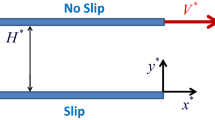Abstract
A new slip velocity model based on molecular potential theory and macro-force analysis, which is applied in Couette flow with pressure gradient, is built up. The model is validated by later being introduced in hydrodynamic system to predict film distribution, which shows a good agreement with experimental data obtained from multi-beam intensity-based tests with Fe and Cu ball materials under accurate controlled temperature, load and different wall velocities. Results show that the slip length for Fe case is ignorable so it seems like no slip, but for Cu case, the slip length is large to make 20% discrepancy with no slip simulation and also behaves shear-dependently. Moreover, during the experimental cases when both Fe and Cu ball velocities rise from −133 mm/s to 1 330 mm/s, the slip velocity changes its direction with entrainment velocity and thus contributes to first enhance and then diminish the hydrodynamic film, but due to slip length on Cu case varying largely than that on Fe case, the film from Cu case and from Fe case has a clear cross-point between ub=80mm/s and ub = 220 mm/s (ub is the ball speed). The results above support strongly that Cu surface will lead to stronger slip than Fe case because of its smaller solid-liquid interaction, and obviously slip will influence hydrodynamic characteristics prominently.
Similar content being viewed by others
References
Stone H. A., Stroock A. D., Ajdari A. Engineering flows in small devices: microfluidics toward a lab-on-a-chip [J]. Annual Review of Fluid Mechanics, 2004, 36: 381–411.
Zhao X., Yuan S., Wei C. Influence of fluid slip on operation characteristics for high-speed spiral groove seal ring [J]. Tribology Letters, 2018, 66(1): 49.
Lee S. J., Kim H. N., Choi W. et al. A nature-inspired lubricant-infused surface for sustainable drag reduction [J]. Soft Matter, 2019, 15(42): 8459–8467.
Schäffel D., Koynov K., Vollmer D. et al. Local flow field and slip length of superhydrophobic surfaces [J]. Physical Review Letters, 2016, 116(13): 134501.
Lee C., Choi C. H., Kim C. J. Superhydrophobic drag reduction in laminar flows: a critical review [J]. Experiments in Fluids, 2016, 57(12): 176.
Akbar N. S., Shoaib M., Tripathi D. et al. Analytical approach to entropy generation and heat transfer in CNT-nanofluid dynamics through a ciliated porous medium [J]. Journal of Hydrodynamics, 2018, 30(2): 296–306.
Rothstein J. P. Slip on superhydrophobic surfaces [J]. Annual Review of Fluid Mechanics, 2010, 42: 89–109.
Vilkner T., Janasek D., Manz A. Micro total analysis systems. recent developments [J]. Analytical Chemistry, 2004, 76(12): 3373–3386.
Stone H. A., Kim S. Microfluidics: Basic issues, applications, and challenges [J]. AIChE Journal, 2001, 47(6): 1250–1254.
Cheng F., Ji W. A velocity-slip model for analysis of the fluid film in the cavitation region of a journal bearing [J]. Tribology International, 2016, 97: 163–172.
Aurelian F., Maspeyrot P., Hajjam M. Wall slip effects in (elasto) hydrodynamic journal bearings [J]. Tribology International, 2011, 44(7): 868–877.
Davis A. M. J., Eric L. Hydrodynamic friction of fakir-like superhydrophobic surfaces [J]. Journal of Fluid Mechanics, 2010, 661: 402–411.
Davis A. M. J., Eric L. The friction of a mesh-like superhydrophobic surface [J]. Physics of Fluids, 2009, 21(11): 015103.
Zhao X., Wei C., Yuan S. Determination of slip length in Couette flow based on an analytical simulation incorporating surface interaction [J]. Chinese Physics Letters, 2017, 34(3): 034701.
Cao B. Y., Chen M., Guo Z. Y. Effect of surface roughness on gas flow in microchannels by molecular dynamics simulation[J]. International Journal of Engineering Science, 2006, 44(13): 927–937.
Dorgan J. R., Rorrer N. A. Molecular scale simulation of homopolymer wall slip [J]. Physical Review Letters, 2013, 110(17): 176001.
Israelachvili J. N. Intermolecular and surface forces [M]. Amsterdam, The Netherlands: Elsevier, 2015.
Bair S., Winer W. O. The high pressure high shear stress rheology of liquid lubricants [J]. Journal of Tribology, 1992, 114(1): 1–9.
Dowson D., Higginson G. R. Elasto-hydrodynamic lubrication: International series on materials science and technology [M]. Amsterdam, The Netherlands: Elsevier, 2014.
Nagayama G., Cheng P. Effects of interface wettability on microscale flow by molecular dynamics simulation [J]. International Journal of Heat and Mass Transfer, 2004, 47(3): 501–513.
Liu Y., Lawal A. Kinetic study of autothermal reforming of glycerol in a dual layer monolith catalyst [J]. Chemical Engineering and Processing: Process Intensification, 2015, 95: 276–283.
Rappé A. K., Casewit C. J., Colwell K. S. et al. UFF, a full periodic table force field for molecular mechanics and molecular dynamics simulations [J]. Journal of the American Chemical Society, 1992, 114(25): 10024–10035.
Guo F., Wong P. L. A multi-beam intensity-based approach for lubricant film measurements in non-conformal contacts [J]. Proceedings of the Institution of Mechanical Engineers, Part J: Journal of Engineering Tribology, 2002, 216(5): 281–291.
Thompson P. A., Troian S. M. A general boundary condition for liquid flow at solid surfaces [J]. Nature, 1997, 389(6649): 360.
Acknowledgement
This work was supported by China Scholarship Council.
Author information
Authors and Affiliations
Corresponding author
Additional information
Biography: Xin Zhao (1991-), Female, Ph. D.
Rights and permissions
About this article
Cite this article
Zhao, X., Wei, C. & Yuan, Sh. Slip in Couette flow with pressure gradient: Theoretical and experimental investigation of hydrodynamic characteristics considering slip effect. J Hydrodyn 32, 107–115 (2020). https://doi.org/10.1007/s42241-020-0007-3
Received:
Revised:
Accepted:
Published:
Issue Date:
DOI: https://doi.org/10.1007/s42241-020-0007-3




